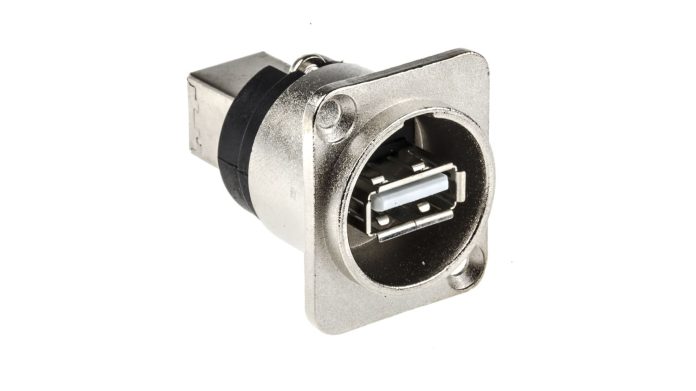Panel Mount is the name to describe mechanical features that have been included as part of the design of a connector half, enabling the connector to be secured onto an enclosure, equipment panel or external case. The majority of connectors that come with panel mount features fitted onto them will be cable connectors such as USB connectors.
How panel mount works
- There are three panel mount position types – rear-face or external mounting, front-face or internal mounting and side mount.
- Rear-face or external mounting sees most of the connector being on the front face or the outside of the equipment panel or box.
- Front-face or internal mounting sees most of the connector being on the rear face or the inside of the equipment panel or box.
- Side mount sees the connector housing being fixed to the horizontally oriented panel, which is more of a method of securing it than an actual connection from the exterior to the interior of an enclosure.
When is panel mount used?
When a connection needs to be made between the exterior and interior of an enclosure, a hole will need to be made in the enclosure panel or wall in order to be able to feed through that connection.
Providing the entire system was designed to be a one-time installation, with no need to replace anything then there is no reason why numerous cables could not be fitted through that hole so that power and/or a signal can be transferred. The only caveat is that the edges need to be lined to ensure the cables are protected.
On the other hand if you need to be able to have the enclosure plugged and unplugged on a regularly basis, or they are being manufactured in different places, then it will be most convenient to have the connection half built into one side of that enclosure, with a cut-out or hole that the connector can sit in.
The interior electronics will be wired to the rear of the panel mount USB connector, which is then fixed within the cut-out.
The advantages of panel mount USB connectors
Panel mount USB connectors come with a number of advantages over cable mount USB connectors. The connector being attached to the panel means that the electrical connections on the rear of the connector are under no external strain, thus making it less likely that they will fail and improving the durability of the device in question.
Untrained users will also be able to safely disconnect and connect cables. A good example of this is the connections on the rear of a PC, all of which are panel mount.
Designing entire modules to be replaceable items within smaller enclosures is also a possibility, and the devices can be kept inside the boxes so as to prevent tampering.
Search for the correct USB connectors from RS components that you need. They can be panel mounted with adhesive methods such as glue instead of mechanical fixings, although mechanical panel mount is recommended for applications that are made use of in more demanding environments in order to ensure connectors do not move away from the panel due to a single bump.
